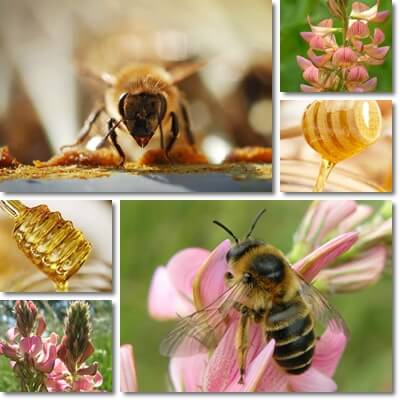Sainfoin honey, also known as lupinella honey, is a variety of floral honey made from the nectar and pollen of Onobrychis viciifolia blossoms. Onobrychis viciifolia, or the common sainfoin, is a flowering plant in the legume or beans family, similar to clover and alfalfa. Its flower nectar is the source of the famous Italian lupinella honey or miele di lupinella, a type of honey with significant antibacterial, antioxidant, anti-inflammatory and cough-supressing properties, digestive benefits, antiparasitic potential and soothing and energy-boosting action.
What is sainfoin or lupinella honey? Sainfoin honey is a type of monofloral honey made from the nectar and pollen of the common sainfoin flowers. Honey bees source the nectar and pollen of the flowers for food and honey production. Both the flower nectar and pollen particles are mixed with enzymes secreted by honey bees and turned into honey and other end products such as bee bread (made from pollen and honey). Sainfoin honey is not the same as Italian sainfoin honey (French honeysuckle or sulla honey), although the similarity of their names may spark confusion.

Despite being a monofloral honey, the variety doesn’t contain nectar exclusively from the common sainfoin flowers. If there are other flowering plants in bloom in the area at the same time as sainfoin, honey bees will not discriminate and collect all available nectar to make honey. However, the variety is called unifloral or monofloral sainfoin honey because it is made almost entirely from sainfoin flower nectar (and pollen). This is true for all monofloral honeys.
What does sainfoin honey look like? The variety has a clear light amber color. It has a medium crystallization time and tends to form finer crystals as it takes on a more solid form. What does sainfoin honey taste and smell like? Sainfoin is a light honey with a pleasant, but not very intense sweetness and light floral notes. Overall, it doesn’t have a very particular flavor profile, which makes it a great natural sweetener for teas and other beverages as it doesn’t change their taste. It isn’t a particularly thick honey either.
Can sainfoin honey cause allergic reactions? You can be allergic to any type of honey and there are two reasons for this: either you are allergic to the enzymes honey bees secrete to make the honey, or you are allergic to plant pollen. If you are allergic to honey bee enzymes and secretions, then this makes you allergic to all honey varieties because they are all made by honey bees and thus contain such enzymes. It also means that you should avoid honey and other bee products.
If you are allergic to pollen, then this makes you allergic to certain honey varieties. For example, being allergic to sainfoin plant pollen makes you allergic to sainfoin honey, being allergic to sunflower pollen makes you allergic to sunflower honey and so on. This also means that you should be avoiding multifloral honeys because they contain pollen from multiple flower species, meaning there is a chance they might contain pollen from a plant species you are allergic to. Also, having multiple pollen allergies makes one more susceptible to allergies in general.

What about the benefits?
What is sainfoin honey (miele di lupinella) good for? Here are the most noteworthy 7 properties and health effects of sainfoin honey:
1) Natural antibacterial. Sainfoin honey owes its antibacterial effects to its good content of hydrogen peroxide, a strong, natural disinfectant, but also low moisture content and low (acidic) pH, properties that help reduce bacterial load and make the honey good for treating respiratory tract infections, symptoms such as sore throat, suppressing cough and improving wound healing time as well as helping reduce acne breakouts. Thanks to its antibacterial action, the honey also has mild anti-inflammatory effects.
Moreover, the presence of pollen in the honey further contributes to its antimicrobial effects. Research has identified pollen as a natural immunomodulator, meaning it stimulates the immune system to respond better to infection in general. For example, studies show pollen increases the number of white blood cells, hence its immune-boosting action.
2) Antioxidant properties. The variety is a source of antioxidant polyphenols, flavonoids and tannins. Antioxidants protect cells against free radical action and prevent damage build up (oxidative stress) that can encourage inflammation and the onset of disease. Studies show that cell damage caused by oxidative stress triggers inflammation and extensive inflammation ultimately leads to disease in the form of chronic illnesses of the muscles, heart, blood vessels, nerves etc.
3) Good for cough and sore throat. Sainfoin honey is good for both cough and sore throat. The consistency of the honey, which is naturally dense and its low moisture content allow it to stick to the throat lining, forming a protective coating that allows it to heal, relieving irritation and pain caused by soreness and suppressing cough. The acidic pH and antibacterial action contribute to reducing bacteria numbers and further help combat infection locally. The honey also has an emollient action, contributing to its soothing effect.
4) Digestive benefits. Raw honey taken on an empty stomach in the morning is a long-known natural remedy for gastritis, helping soothe irritation of the stomach lining. The stronger the antibacterial properties of the honey, the more potent its effect in helping treat gastritis. The honey is believed to protect the inflamed stomach lining from further irritation and allow it to heal gradually thanks to its dense consistency. Nevertheless, remember that honey alone does not constitute treatment for gastritis. Medication from your doctor and a strict eating plan are important aspects of gastritis treatment. Honey, however effective, remains a complementary, alternative approach to treating gastritis.
Moreover, the natural sugars in sainfoin honey are believed to have prebiotic effects, meaning they feed the good bacteria in our digestive tract. This is believed to help improve intestinal motility and regulate transit time, aiding with constipation relief. However, such effects are, at most, mild and do not constitute an efficient approach to treating constipation if they are not supported by serious dietary changes.
5) Source of vitamins and minerals. All honey types contain trace amounts of a variety of essential nutrients, particularly vitamin C, B vitamins, potassium, calcium, magnesium and other vitamins and dietary minerals. Darker honeys like manuka, arbutus (strawberry tree), chestnut or forest honeys tend to have a higher nutritional value, but vitamin and mineral content differs greatly from one jar of honey to another so the jar of lupinella honey you may be enjoying right now might just be as full of nutrients as the best of forest honeys.
6) Tonic action. The natural sugars, vitamins, minerals, amino acids, antioxidants and other elements with nutritional value such as propolis, beeswax or pollen in sainfoin honey all contribute to its tonic, energizing action. Taking one tablespoon of honey when you’re not feeling very high on energy or when you’re feeling hypoglycemic can be enough to perk you up and can last you a good 15 minutes till your next meal.
7) Good for intestinal parasites. Research has revealed the common sainfoin possesses anthelminthic or antiparasitic properties, helping reduce the number of intestinal parasites in ruminant animals such as cattle or sheep. Because it has been observed on other occasions that certain compounds are passed down from the plant of origin into the honey via nectar or other elements honey bees make use of, the idea that sainfoin honey supposedly boasts antiparasitic benefits and helps get rid of intestinal parasites has been advanced. However, considering the dangers of worms and intestinal parasites infections, if you suspect something like this, it is important that you immediately address your doctor for adequate treatment.
Conclusion
Sainfoin honey, the English correspondent of the famous Italian miele di lupinella, is a healthy honey with a good nutritional and antioxidant value. Its antibacterial, anti-inflammatory, soothing and emollient action, digestive benefits and tonic effect recommend it for consumption, provided, of course, you are not allergic to it. In order to enjoy all the health benefits it has to offer, the honey should only be eaten raw and processing and heating of any kind should be avoided.
